Financial Accounting Report: Shares, Bonds, and Market Overview
VerifiedAdded on 2020/02/24
|6
|830
|65
Report
AI Summary
This financial accounting report provides an in-depth analysis of the stock and bond markets, focusing on market trends and investment returns. The report begins with an introduction discussing the importance of understanding these markets, followed by a detailed market overview of shares and bonds. It examines key financial ratios for both stocks and bonds, including price-to-earnings ratios, dividend yields, and return on equity, comparing industry ratios with the report's data. The analysis considers economic factors influencing market performance, such as interest rates and inflation expectations, and forecasts market returns based on historical averages. The conclusion emphasizes the importance of investors reviewing and resetting their long-term financial goals based on disciplined projections rather than historical averages. The report includes a comprehensive reference list of sources used in the analysis.
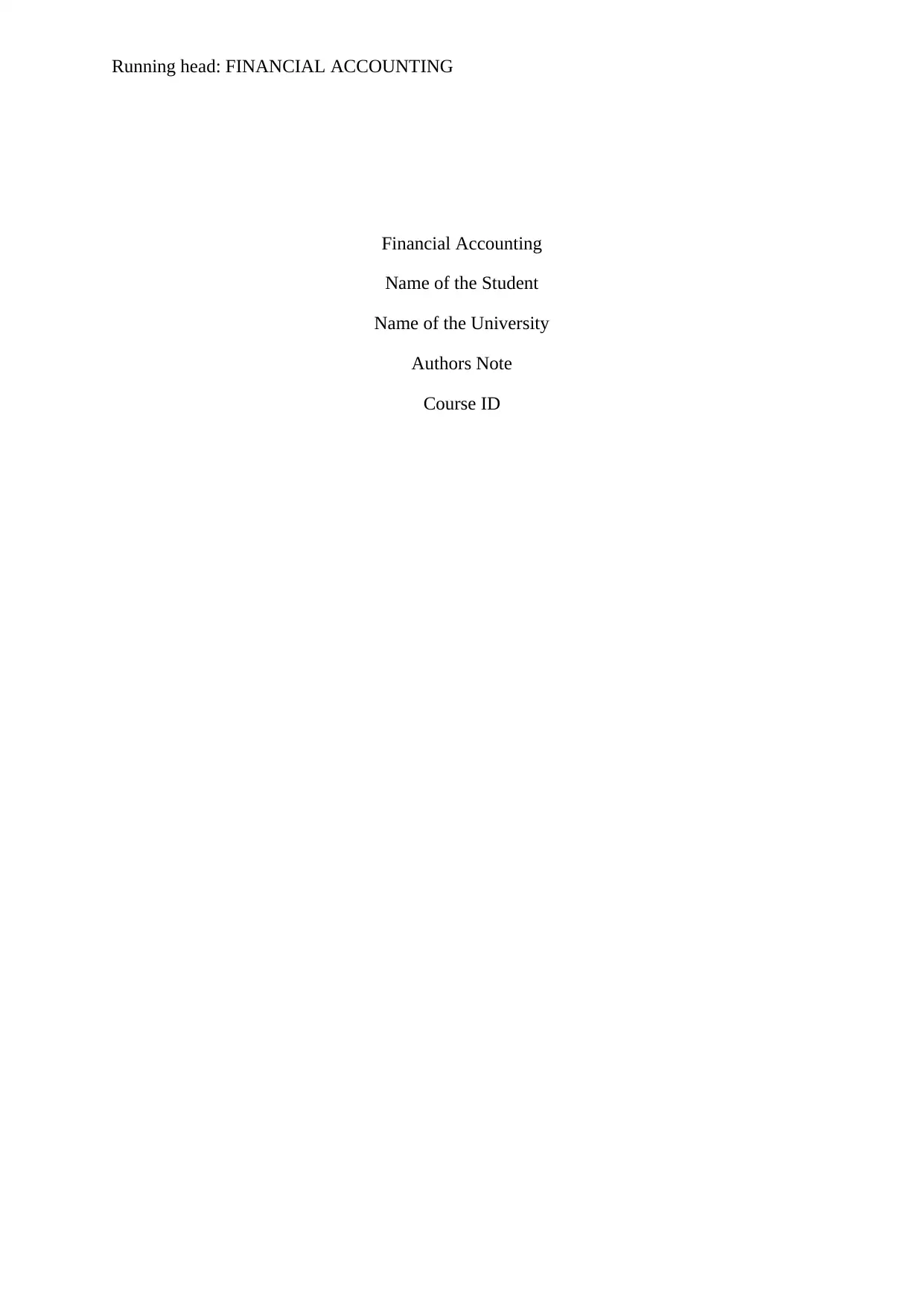
Running head: FINANCIAL ACCOUNTING
Financial Accounting
Name of the Student
Name of the University
Authors Note
Course ID
Financial Accounting
Name of the Student
Name of the University
Authors Note
Course ID
Paraphrase This Document
Need a fresh take? Get an instant paraphrase of this document with our AI Paraphraser
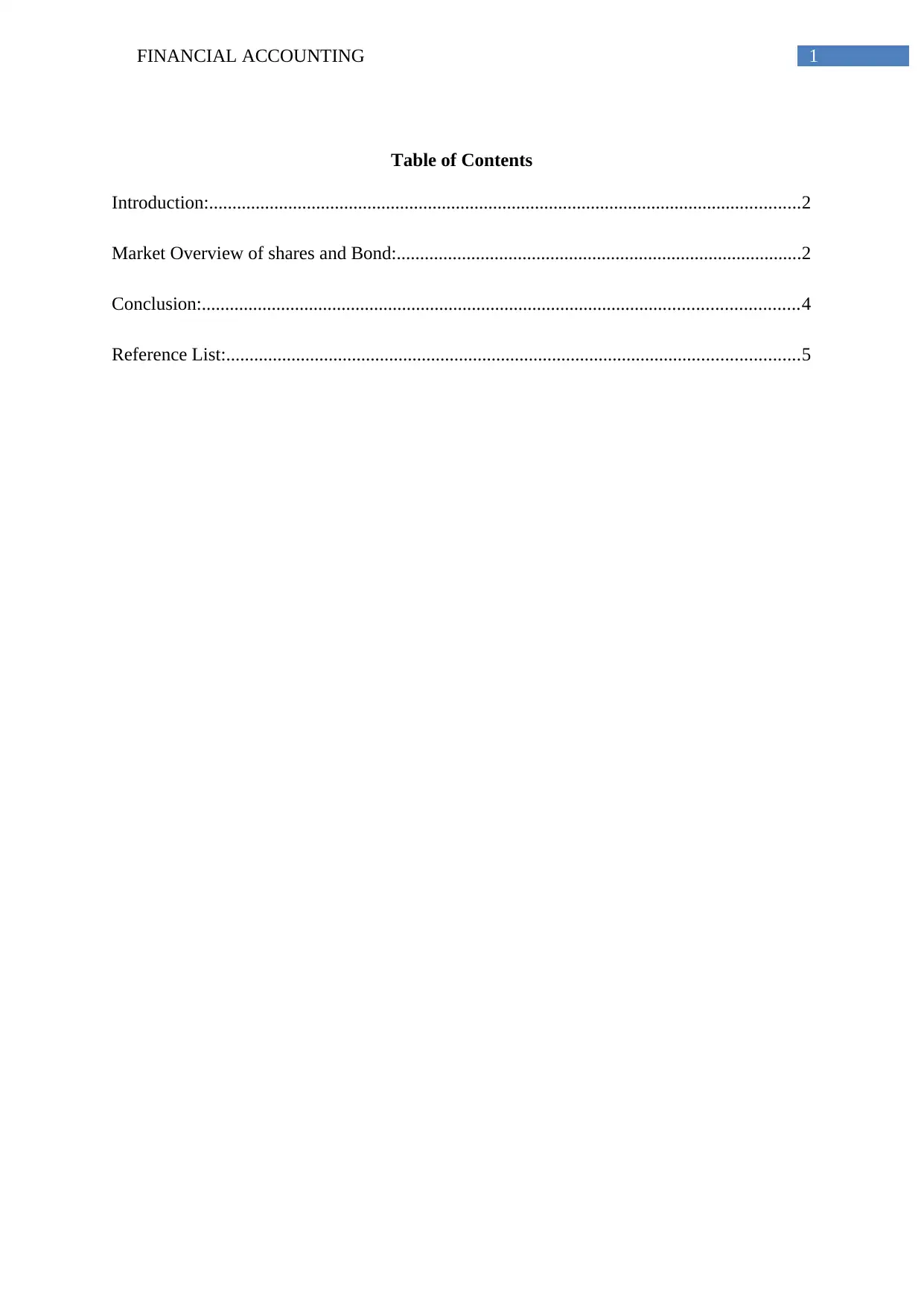
1FINANCIAL ACCOUNTING
Table of Contents
Introduction:...............................................................................................................................2
Market Overview of shares and Bond:.......................................................................................2
Conclusion:................................................................................................................................4
Reference List:...........................................................................................................................5
Table of Contents
Introduction:...............................................................................................................................2
Market Overview of shares and Bond:.......................................................................................2
Conclusion:................................................................................................................................4
Reference List:...........................................................................................................................5
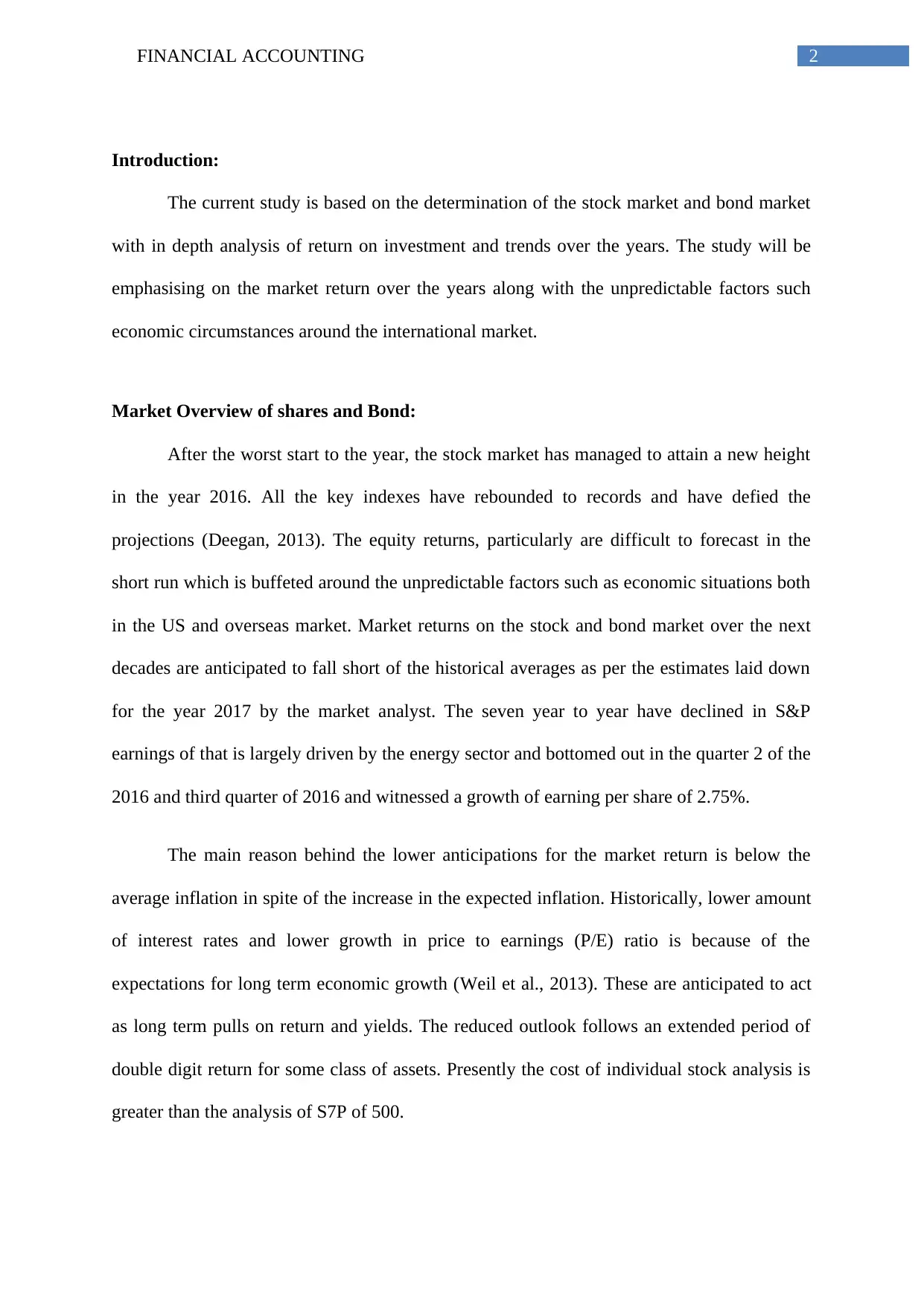
2FINANCIAL ACCOUNTING
Introduction:
The current study is based on the determination of the stock market and bond market
with in depth analysis of return on investment and trends over the years. The study will be
emphasising on the market return over the years along with the unpredictable factors such
economic circumstances around the international market.
Market Overview of shares and Bond:
After the worst start to the year, the stock market has managed to attain a new height
in the year 2016. All the key indexes have rebounded to records and have defied the
projections (Deegan, 2013). The equity returns, particularly are difficult to forecast in the
short run which is buffeted around the unpredictable factors such as economic situations both
in the US and overseas market. Market returns on the stock and bond market over the next
decades are anticipated to fall short of the historical averages as per the estimates laid down
for the year 2017 by the market analyst. The seven year to year have declined in S&P
earnings of that is largely driven by the energy sector and bottomed out in the quarter 2 of the
2016 and third quarter of 2016 and witnessed a growth of earning per share of 2.75%.
The main reason behind the lower anticipations for the market return is below the
average inflation in spite of the increase in the expected inflation. Historically, lower amount
of interest rates and lower growth in price to earnings (P/E) ratio is because of the
expectations for long term economic growth (Weil et al., 2013). These are anticipated to act
as long term pulls on return and yields. The reduced outlook follows an extended period of
double digit return for some class of assets. Presently the cost of individual stock analysis is
greater than the analysis of S7P of 500.
Introduction:
The current study is based on the determination of the stock market and bond market
with in depth analysis of return on investment and trends over the years. The study will be
emphasising on the market return over the years along with the unpredictable factors such
economic circumstances around the international market.
Market Overview of shares and Bond:
After the worst start to the year, the stock market has managed to attain a new height
in the year 2016. All the key indexes have rebounded to records and have defied the
projections (Deegan, 2013). The equity returns, particularly are difficult to forecast in the
short run which is buffeted around the unpredictable factors such as economic situations both
in the US and overseas market. Market returns on the stock and bond market over the next
decades are anticipated to fall short of the historical averages as per the estimates laid down
for the year 2017 by the market analyst. The seven year to year have declined in S&P
earnings of that is largely driven by the energy sector and bottomed out in the quarter 2 of the
2016 and third quarter of 2016 and witnessed a growth of earning per share of 2.75%.
The main reason behind the lower anticipations for the market return is below the
average inflation in spite of the increase in the expected inflation. Historically, lower amount
of interest rates and lower growth in price to earnings (P/E) ratio is because of the
expectations for long term economic growth (Weil et al., 2013). These are anticipated to act
as long term pulls on return and yields. The reduced outlook follows an extended period of
double digit return for some class of assets. Presently the cost of individual stock analysis is
greater than the analysis of S7P of 500.
⊘ This is a preview!⊘
Do you want full access?
Subscribe today to unlock all pages.

Trusted by 1+ million students worldwide
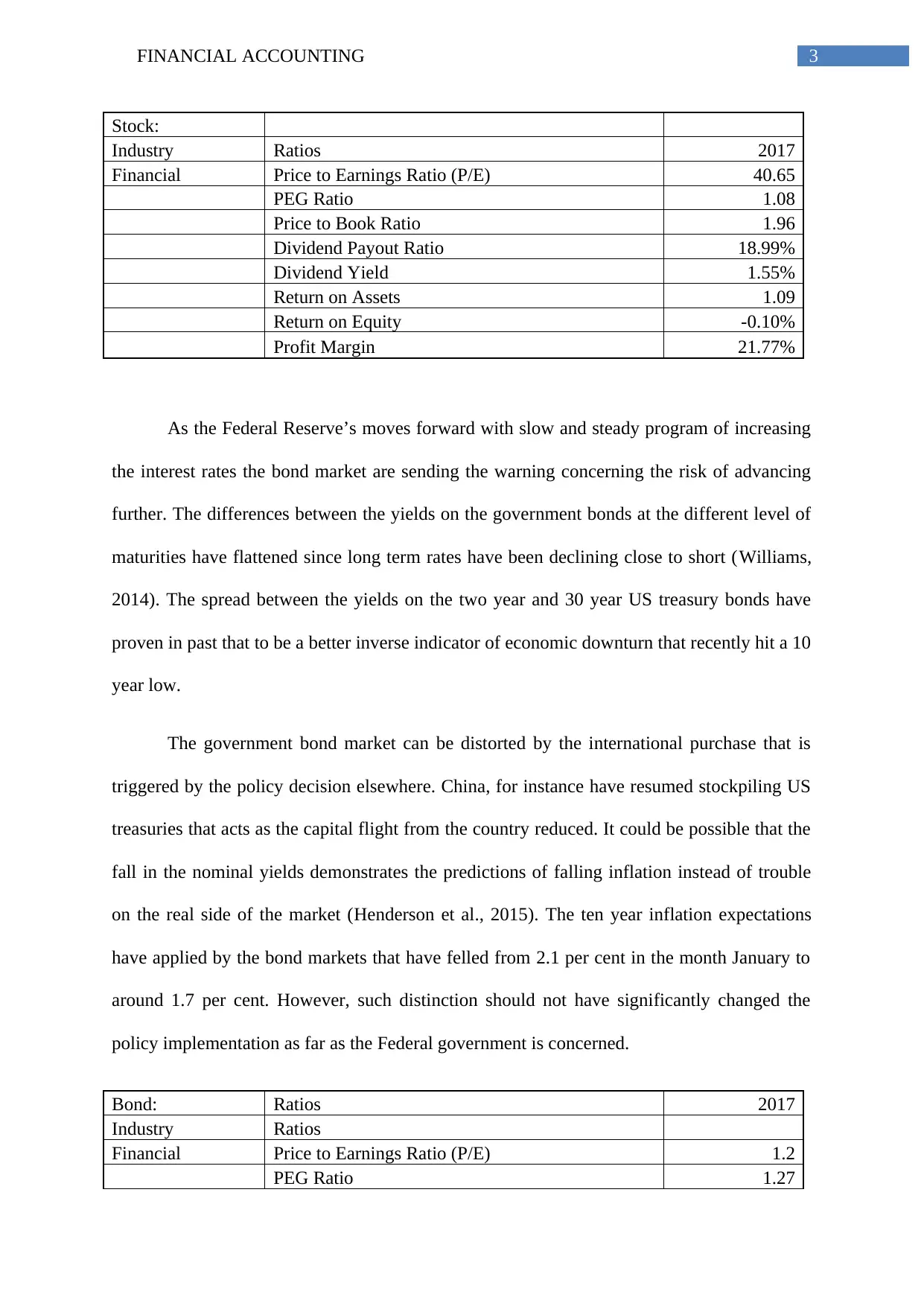
3FINANCIAL ACCOUNTING
Stock:
Industry Ratios 2017
Financial Price to Earnings Ratio (P/E) 40.65
PEG Ratio 1.08
Price to Book Ratio 1.96
Dividend Payout Ratio 18.99%
Dividend Yield 1.55%
Return on Assets 1.09
Return on Equity -0.10%
Profit Margin 21.77%
As the Federal Reserve’s moves forward with slow and steady program of increasing
the interest rates the bond market are sending the warning concerning the risk of advancing
further. The differences between the yields on the government bonds at the different level of
maturities have flattened since long term rates have been declining close to short (Williams,
2014). The spread between the yields on the two year and 30 year US treasury bonds have
proven in past that to be a better inverse indicator of economic downturn that recently hit a 10
year low.
The government bond market can be distorted by the international purchase that is
triggered by the policy decision elsewhere. China, for instance have resumed stockpiling US
treasuries that acts as the capital flight from the country reduced. It could be possible that the
fall in the nominal yields demonstrates the predictions of falling inflation instead of trouble
on the real side of the market (Henderson et al., 2015). The ten year inflation expectations
have applied by the bond markets that have felled from 2.1 per cent in the month January to
around 1.7 per cent. However, such distinction should not have significantly changed the
policy implementation as far as the Federal government is concerned.
Bond: Ratios 2017
Industry Ratios
Financial Price to Earnings Ratio (P/E) 1.2
PEG Ratio 1.27
Stock:
Industry Ratios 2017
Financial Price to Earnings Ratio (P/E) 40.65
PEG Ratio 1.08
Price to Book Ratio 1.96
Dividend Payout Ratio 18.99%
Dividend Yield 1.55%
Return on Assets 1.09
Return on Equity -0.10%
Profit Margin 21.77%
As the Federal Reserve’s moves forward with slow and steady program of increasing
the interest rates the bond market are sending the warning concerning the risk of advancing
further. The differences between the yields on the government bonds at the different level of
maturities have flattened since long term rates have been declining close to short (Williams,
2014). The spread between the yields on the two year and 30 year US treasury bonds have
proven in past that to be a better inverse indicator of economic downturn that recently hit a 10
year low.
The government bond market can be distorted by the international purchase that is
triggered by the policy decision elsewhere. China, for instance have resumed stockpiling US
treasuries that acts as the capital flight from the country reduced. It could be possible that the
fall in the nominal yields demonstrates the predictions of falling inflation instead of trouble
on the real side of the market (Henderson et al., 2015). The ten year inflation expectations
have applied by the bond markets that have felled from 2.1 per cent in the month January to
around 1.7 per cent. However, such distinction should not have significantly changed the
policy implementation as far as the Federal government is concerned.
Bond: Ratios 2017
Industry Ratios
Financial Price to Earnings Ratio (P/E) 1.2
PEG Ratio 1.27
Paraphrase This Document
Need a fresh take? Get an instant paraphrase of this document with our AI Paraphraser
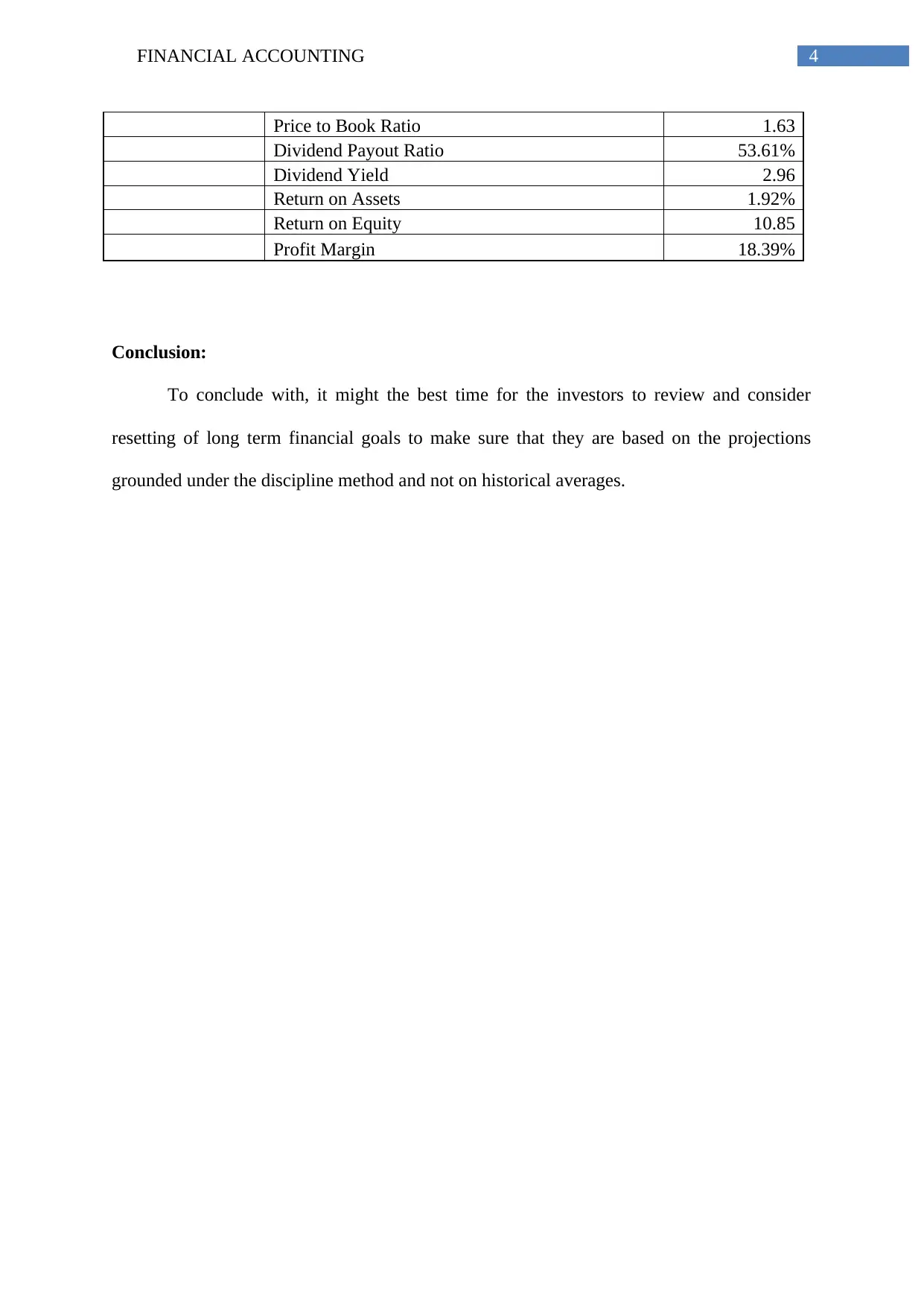
4FINANCIAL ACCOUNTING
Price to Book Ratio 1.63
Dividend Payout Ratio 53.61%
Dividend Yield 2.96
Return on Assets 1.92%
Return on Equity 10.85
Profit Margin 18.39%
Conclusion:
To conclude with, it might the best time for the investors to review and consider
resetting of long term financial goals to make sure that they are based on the projections
grounded under the discipline method and not on historical averages.
Price to Book Ratio 1.63
Dividend Payout Ratio 53.61%
Dividend Yield 2.96
Return on Assets 1.92%
Return on Equity 10.85
Profit Margin 18.39%
Conclusion:
To conclude with, it might the best time for the investors to review and consider
resetting of long term financial goals to make sure that they are based on the projections
grounded under the discipline method and not on historical averages.
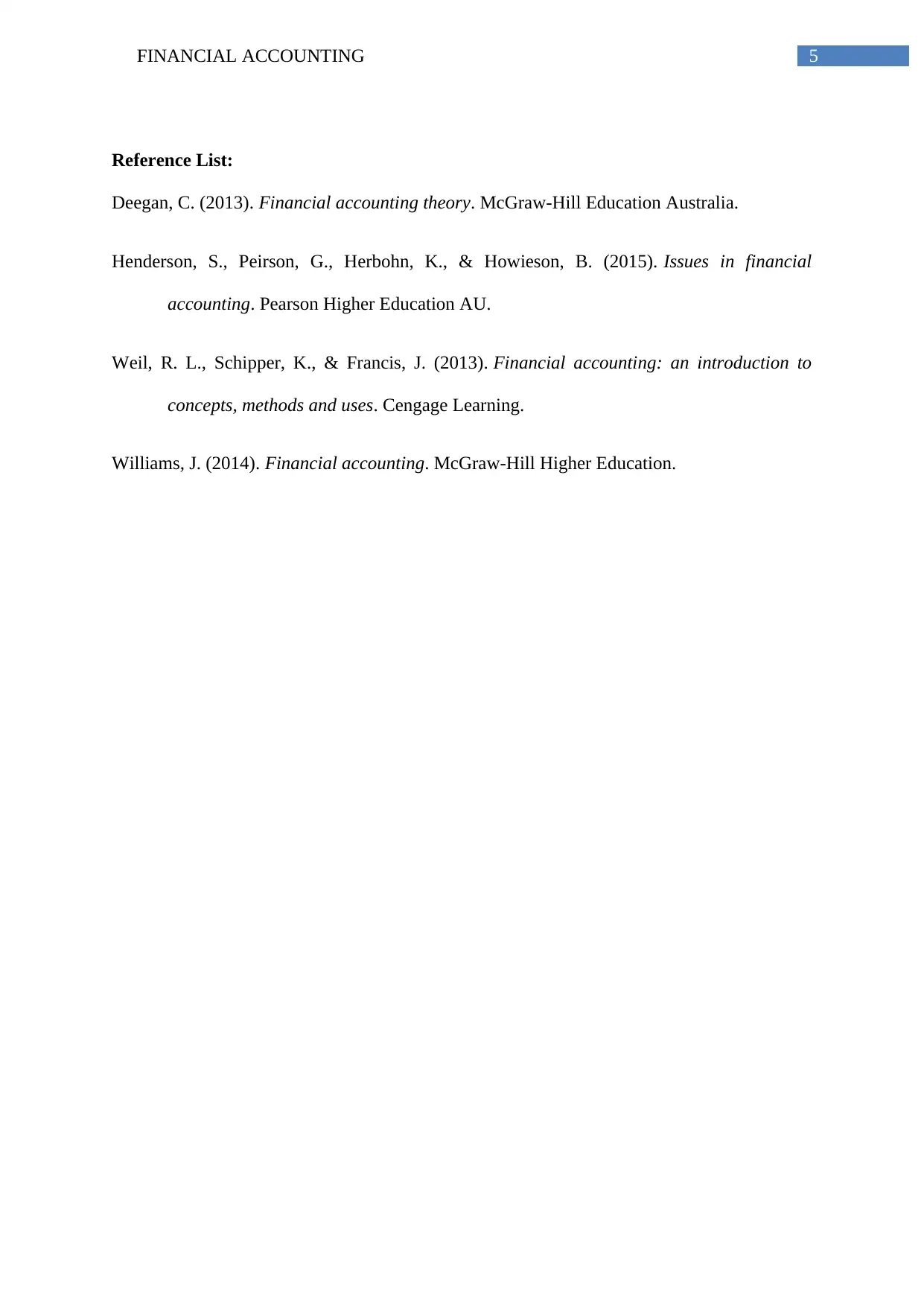
5FINANCIAL ACCOUNTING
Reference List:
Deegan, C. (2013). Financial accounting theory. McGraw-Hill Education Australia.
Henderson, S., Peirson, G., Herbohn, K., & Howieson, B. (2015). Issues in financial
accounting. Pearson Higher Education AU.
Weil, R. L., Schipper, K., & Francis, J. (2013). Financial accounting: an introduction to
concepts, methods and uses. Cengage Learning.
Williams, J. (2014). Financial accounting. McGraw-Hill Higher Education.
Reference List:
Deegan, C. (2013). Financial accounting theory. McGraw-Hill Education Australia.
Henderson, S., Peirson, G., Herbohn, K., & Howieson, B. (2015). Issues in financial
accounting. Pearson Higher Education AU.
Weil, R. L., Schipper, K., & Francis, J. (2013). Financial accounting: an introduction to
concepts, methods and uses. Cengage Learning.
Williams, J. (2014). Financial accounting. McGraw-Hill Higher Education.
⊘ This is a preview!⊘
Do you want full access?
Subscribe today to unlock all pages.

Trusted by 1+ million students worldwide
1 out of 6
Related Documents
Your All-in-One AI-Powered Toolkit for Academic Success.
+13062052269
info@desklib.com
Available 24*7 on WhatsApp / Email
![[object Object]](/_next/static/media/star-bottom.7253800d.svg)
Unlock your academic potential
Copyright © 2020–2025 A2Z Services. All Rights Reserved. Developed and managed by ZUCOL.




